Therapy | Writing | Presentations | Training | Advice | Gus CV | Travel | Sex | Contact me
Home
guscairns.com
Kilimanjaro diary - day six
Day one Day two Day three Day four Day five Day Six Day seven
No pictures till halfway down this page, because you do the last bit at night.
We were woken at 11.30pm. It was icy cold. We struggled into every layer of clothing we'd brought with us. I had a down ski jacket that kept me warm: about the only bit of me that wasn't properly catered for were my hands, despite my gloves being ones bought in New York and supposedly designed for snowy winters. My fingers would be aching with cold all night. The other piece of equipment that proved inadequate was my head torch, battery stunned dead by the cold; it worked perfectly well after our trip. We loaded up with hot sweet tea, stuffed our water bottles in towels - to stop them freezing solid on the way up - and started our final ascent, me picking my way carefully in Roger's footsteps, guided only by his torch.
You didn't feel like saying much. you were breathless; you were scared you wouldn't make it and this would prove impossible. And you were stunned by the grandeur of the starry sky about you, stars blazing down through the thin air.
I was the only member of the group who'd done anything like this before. Throughout the 1990s I'd helped to run the Gay Men's Weeks organised by the Edward Carpenter Community at Laurieston Hall in Scotland (see the ECC link on the left) and a speciality of mine had been a 'workshop' involving a midnight, torchlit walk up a mountain to build a bonfire at the top and see in the dawn. I'd always loved the way the specialness of the world revealed itself slowly as the new day's light increased and we climbed higher and higher above the landscape. That, however, was a couple of hours' stroll up a 400-metre hummock. This was an ascent comparable to Ben Nevis, done in minus-20 temperatures and at altitude.
I knew what to do. You don't struggle. You just take one, slow, measured step after another, like a little machine. You get into the rhythm, not stopping too often because that breaks it. Sometimes you walk backwards up the slope for a few steps to exercise different muscles. You keep going and going and going.
Walking backwards also exposed you to the view. You couldn't see a lot of the surroundings - there were just the vaguest hint of dark slopes picked out in starlight - but the celestial panorama above grew ever more dazzling as the air got thinner. One, two, three bright meteors sliced the sky. And then, as we got higher, the stars were joined by rows of yellow lights below. Underneath us and also about a kilometre off towards the east you could see thin, wavering lines of torches as other climbers made their ascent, the other line being walkers coming up via the 'easy' route from Kibo Hut. It felt quite magical. If you've seen Disney's Fantasia you'll remember the boring bit at the end accompanying Schubert's Ave Maria of a pilgrims with lights processing through a mystical landscape. It felt like that. I'm not saying we were doing anything spiritual, but walking up high mountains has always been a theme in religious traditions (think Fuji, Croagh Patrick, Mount Sinai) and I'm sure Kili must have been sacred to the local people. It couldn't not be.
I was fine, happy to trudge ever on with the occasional break for tea. But Mark was having trouble. He was getting slower and slower, having to pause more and more often. I was impatient at first, then I got worried; I asked him if he was OK and he didn't respond. Isaac was clearly worried too. If we didn't get to the crater rim by dawn we wouldn't make the ascent because you couldn't leave to summit too late of you'd get trapped in mist.
Later, Mark told me about it. He said he'd been hallucinating from the lack of oxygen, lost in a dark tunnel with occasional demon shadows and flickering lights coming at him from the sides. The shape of his mittens on his trekking poles had been like bats swooping angrily at his face. He'd lost any memory of what he was doing or where he was but just remembered he had to keep moving forward and upward. He started off with a mantra in his head saying "I am Mark W and I'm going to do this." Later on it was replaced by "I'm Mark W and I'm not going to die." I don't know if I would have kept going under similar circumstances, although there is very little option; stopping is a bad idea (altitude symptoms get worse if you rest because the heart slows down) and descending would mean defeat.
It got ever colder; I couldn't see the beginnings of the glaciers but I could see that the shadow of the slope off to out left became sharper and that a knife-edge wind, as cold as dry ice, was sweeping off it. About 4am a crescent moon rose and glinted off the ice. Eventually, however, the sky started to brighten, showing that we were very near the top.
Just the last bit
was a killer. Finally any path where there are friendly rocks to step on and lever
yourself up by disappears and the last 150 metres or so is a climb up a
45-degree slope of shifting volcanic sand that involved two steps back for every three taken forward. Finally I started feeling really sick
and ill myself - lights flashing at the side of my vision like a migraine,
wanting to throw up, probably what Mark had been experiencing all night. The
landscape started sliding across my filed of vision like an old-fashioned
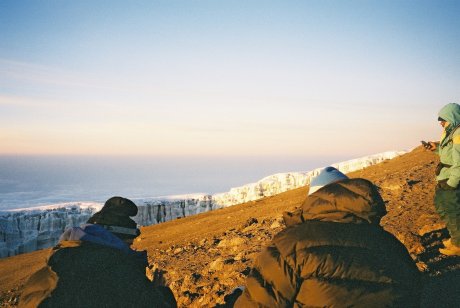 TV
with bad horizontal hold. But it didn't last. Suddenly there was no slope in
front of us, and we were at Stella Point on the crater rim.
TV
with bad horizontal hold. But it didn't last. Suddenly there was no slope in
front of us, and we were at Stella Point on the crater rim.
I'd like to say we
got there as the sun rose but in fact it was about 10 minutes after that, as
you can see from the light in the photo on the left, with the rising sun
striking the glacier in the background. As soon as the sun rose in this
thin,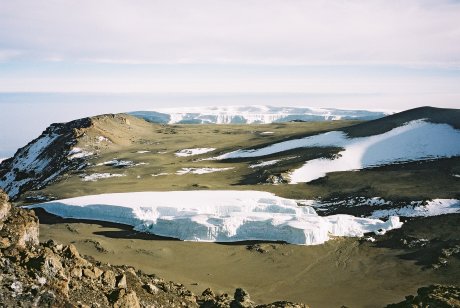 equatorial air, the temperature shot up to relatively acceptable and Mark
revived completely - it was as if his personality came back.
equatorial air, the temperature shot up to relatively acceptable and Mark
revived completely - it was as if his personality came back.
We looked around.
We had walked, or so it looked like to me, to Mars. we were standing on the
rim of the shallow bowl of the crater overlooking a desert or utterly
plantless reddish-brown boulders and sand.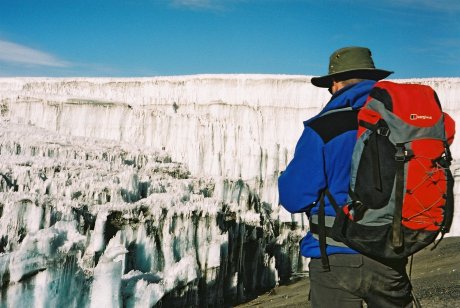 But it was Mars at its South Pole, a Mars on to which some gigantic space
freighter had dropped Antarctic icebergs.
But it was Mars at its South Pole, a Mars on to which some gigantic space
freighter had dropped Antarctic icebergs.
All we had left
was the easy walk round the crater rim to the summit. As we walked, the
glaciers talked to us: deep, musical booms and tocks came out of their
depths as the ice expanded in the sunlight. Isaac pointed to a tall pole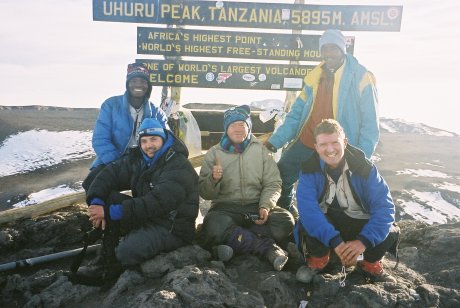 sticking out of one - a measuring device. "When I first came up here about
15 years ago," he said, "The top of that pole was at the surface of the
glacier." Now nearly 20 feet protruded. It will be a great tragedy when the
last of the snows melt and Kilimanjaro goes silent as its glacier-fed
streams dry up.
sticking out of one - a measuring device. "When I first came up here about
15 years ago," he said, "The top of that pole was at the surface of the
glacier." Now nearly 20 feet protruded. It will be a great tragedy when the
last of the snows melt and Kilimanjaro goes silent as its glacier-fed
streams dry up.
Finally we were
there, Uhuru Peak, the summit.
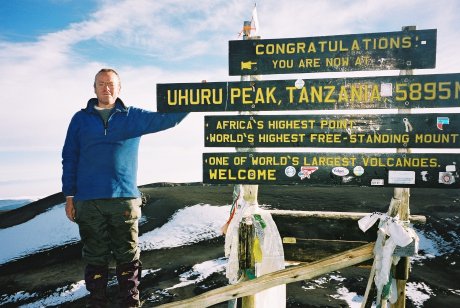 At
first I felt just relief and then triumph, as we skipped round animatedly
despite the altitude and took photos. Then a moment's trek-rage as this
wanky South African, who'd ice-climbed up the Western Breach route in three
days, pronounced that "you needed balls" to do it his way, and I felt like
holding him down and chopping his off...
At
first I felt just relief and then triumph, as we skipped round animatedly
despite the altitude and took photos. Then a moment's trek-rage as this
wanky South African, who'd ice-climbed up the Western Breach route in three
days, pronounced that "you needed balls" to do it his way, and I felt like
holding him down and chopping his off...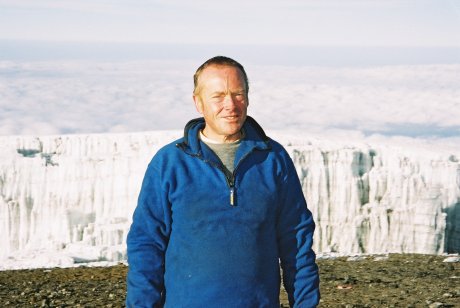
Then, finally it
hit me and I started crying. The thought that did it was I am never going
to be here again and I realised that this really was a Peak Experience,
one of
those lifetime moments I will take to my grave, and one I wouldn't have had
if I'd gone to my grave, as seemed so likely, in 1997.
I wasn't alone;
Roger, who liked to present himself as a crusty old hack, was in tears too.
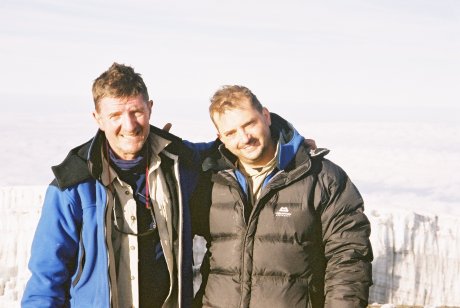 As
I was writing this three years later I kept referring to the diary I'd
written at the time, but found I didn't need to: I haven't forgotten a
single detail.
As
I was writing this three years later I kept referring to the diary I'd
written at the time, but found I didn't need to: I haven't forgotten a
single detail.
Well, we would have liked to stay there longer but couldn't, and eventually , after 45 minutes at the top of Africa, we had to leave. It was 9am and the day was only one-third over: we had over 10,000 feet of descent to do before we could rest for the night.
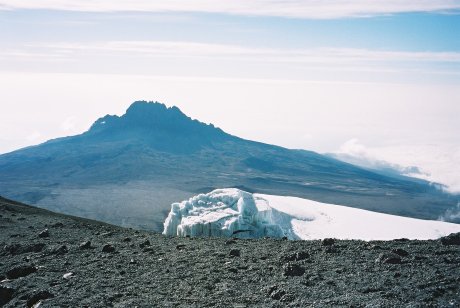 I
paused to take what I think is the best picture
è I took all holiday - look at
that composition! - and then down over the crater rim we swooped.
I
paused to take what I think is the best picture
è I took all holiday - look at
that composition! - and then down over the crater rim we swooped.
Well, I did,
anyway. I'd done scree-running in the Lake District and knew the safest way
to get down a steep gravel slope is the fastest - to lean back, dig your
heels in and then basically run. It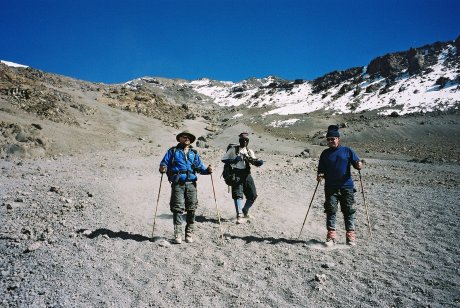 also felt, after four days of
inching along like an old granny, like a blissful relief to cover ground
fast. Roger and Mark didn't feel the same and plodded down cautiously,
poking the sand with their trekking poles. I felt a bit guilty leaving them
behind; but I got my comeuppance later.
also felt, after four days of
inching along like an old granny, like a blissful relief to cover ground
fast. Roger and Mark didn't feel the same and plodded down cautiously,
poking the sand with their trekking poles. I felt a bit guilty leaving them
behind; but I got my comeuppance later.
We were
allowed a couple of hours' nap and a brunch-break at Barafu Camp and then
started a long, long descent, at first along the summit of the rocky ridge
to camp is perched on and then down an endless slope, at first deserty but
later park-like as the scrubland and eventually the tall tree-heathers
started to grow around us. It wasn't nearly as picturesque as the way we'd
come and I'm glad we chose the route we did.
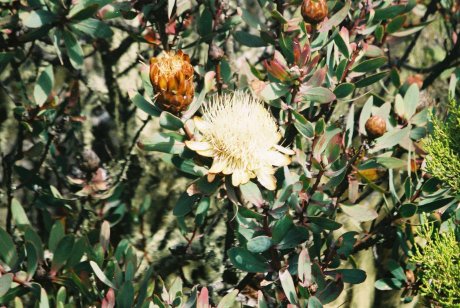 Because
there was nothing much to look at, I took pictures of flowers insteadè.
Because
there was nothing much to look at, I took pictures of flowers insteadè.
Suddenly, I was the one who was suffering, the footdragger who kept begging for rest as the others plodded steadily ahead. I've always preferred ascent to descent and the way down Kilimanjaro seemed to consist of an endless series of steps. My toes banged into the end of my boots with each step, my knees ached and I felt sick from the constant jarring. Mark and roger, meanwhile, forged gaily ahead. My toes got so badly bruised my right big toe nail went black and eventually fell off - the one injury of any consequence I sustained on the trip (it's since regrown).
The other person lagging behind was our guide Fred, who eventually disappeared completely. I mentioned this to our chief guide Isaac and asked if he was all right. "He's a human being, just like you!" he snapped back. I suppose i thought of our guides as superhumans or at least accustomed to the rigours of Kili. They so about a trip a month in the dry season - that's four to six a year, three weeks off and one week climbing. This one was quite enough to knacker me.
%20camp.jpg) We
finally stumbled into the last camp, Mweka camp, shortly before sunset. We
had been on our feet for most of the last 18 hours and had covered 4,000
metres or 14,000 feet of vertical ascent. This was a luxury holiday complex
compared with anything else we'd seen so far with a paid bar from which I
finally bought a nice cold BEER. Then I fell into my sleeping bag and
collapsed into a dreamless, 12 hour sleep.
We
finally stumbled into the last camp, Mweka camp, shortly before sunset. We
had been on our feet for most of the last 18 hours and had covered 4,000
metres or 14,000 feet of vertical ascent. This was a luxury holiday complex
compared with anything else we'd seen so far with a paid bar from which I
finally bought a nice cold BEER. Then I fell into my sleeping bag and
collapsed into a dreamless, 12 hour sleep.